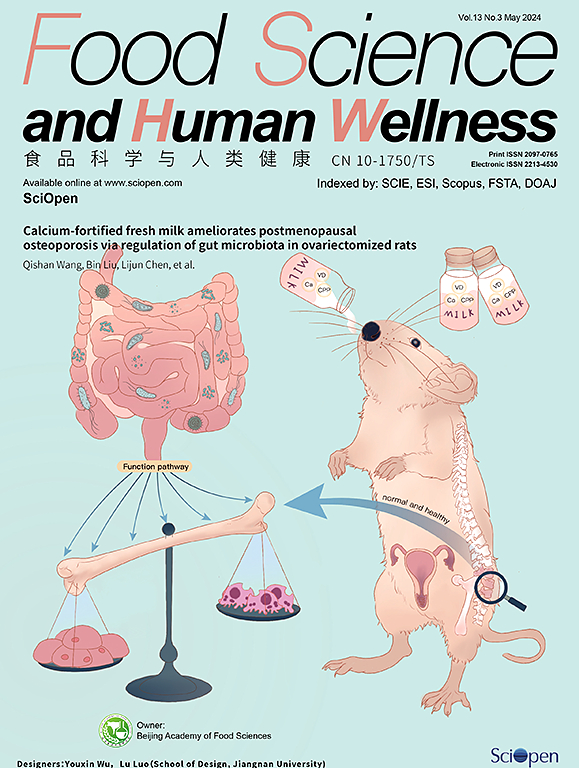膳食橄榄油、山茶籽油和大豆油对心血管疾病高危女性血清脂质组成的影响:脂质组分析
IF 7.4
1区 农林科学
Q1 FOOD SCIENCE & TECHNOLOGY
引用次数: 0
摘要
目前,许多研究比较了心血管疾病(CVD)患者和健康个体的脂质代谢,以确定预测CVD的脂质标志物。在这项研究中,基于多维质谱的霰弹枪脂质组学被用于检测一项临床随机对照喂养试验参与者的血清脂质组学,这些参与者接受橄榄油(OO)、茶籽油(CSO)和大豆油(SO)的饮食干预。共鉴定出189种脂类分子,其中磷脂酰肌醇14种,乙醇胺甘油(PE) 45种,胆碱甘油磷脂(PC) 47种,三酰基甘油(TAG) 39种,溶血磷脂18种,鞘磷脂26种。经筛选,发现10个脂质标志物,其中TAG组18:2脂肪酸(FA)、16:1脂肪酸、C54:4/C55:11、C54:3/C55:10、C52:3/C53:10、PC组p18:0/20:0、a18:0/18:1、PE组p18:1/20:4在SO组与OO、CSO组有差异调节。PC池中的d16:0/18:1和TAG池中的C52:2/C53:9受到OO和CSO的不同调节。TAG池C52:2/C53:9与天冬氨酸转氨酶(r = -0.363, P = 0.048)、高密度脂蛋白胆固醇(r = -0.519, P <;0.01)。本研究为研究膳食脂肪对血脂代谢的影响提供了参考。本文章由计算机程序翻译,如有差异,请以英文原文为准。
Effects of dietary olive oil, camellia seed oil and soybean oil on serum lipid composition in women with a high risk of cardiovascular disease: a lipidomic analysis
Numerous studies currently compare the lipid metabolism in patients with cardiovascular disease (CVD) and healthy individuals to identify lipid markers for predicting CVD. In this study, multidimensional mass spectrometry-based shotgun lipidomics was used to examine the serum lipidomics of participants in a clinical randomized controlled feeding trial undergoing olive oil (OO), camellia seed oil (CSO), and soybean oil (SO) dietary interventions. 189 lipid molecules are identified, including 14 species of phosphatidylinositol, 45 species of ethanolamine glycerols (PE), 47 species of choline glycerophospholipids (PC), 39 species of triacylglycerols (TAG), 18 species of lysophosphatidylcholine, and 26 species of sphingomyelin. After screening, 10 lipid markers are found, among which 18:2 fatty acid (FA), 16:1 FA, C54:4/C55:11, C54:3/C55:10, and C52:3/C53:10 in TAG pool, p18:0/20:0 and a18:0/18:1 in PC pool, and p18:1/20:4 in PE pool have differential regulation in the SO group compared to OO and CSO. The d16:0/18:1 in PC pool and C52:2/C53:9 in TAG pool are differentially regulated by OO and CSO. The C52:2/C53:9 in TAG pool has a significant negative correlation with aspartate aminotransferase (r = -0.363, P = 0.048) and high-density lipoprotein cholesterol (r = -0.519, P < 0.01). This study provides a reference for researching the effect of dietary fat on blood lipid metabolism.
求助全文
通过发布文献求助,成功后即可免费获取论文全文。
去求助
来源期刊

Food Science and Human Wellness
Agricultural and Biological Sciences-Food Science
CiteScore
8.30
自引率
5.70%
发文量
80
审稿时长
28 days
期刊介绍:
Food Science and Human Wellness is an international peer-reviewed journal that provides a forum for the dissemination of the latest scientific results in food science, nutriology, immunology and cross-field research. Articles must present information that is novel, has high impact and interest, and is of high scientific quality. By their effort, it has been developed to promote the public awareness on diet, advocate healthy diet, reduce the harm caused by unreasonable dietary habit, and directs healthy food development for food industrial producers.
 求助内容:
求助内容: 应助结果提醒方式:
应助结果提醒方式:


